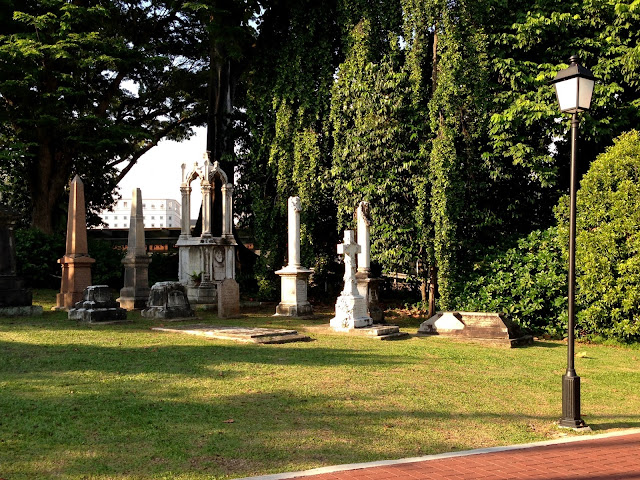Fort Canning Park sits atop a low hill. It is our island historical landmark. Stamford Raffles built his first governor's residence atop the hill and grew nutmeg and clove at an experimental botanical garden here in 1822. In olden times, the native Malays called this hill Bukit Larangan or Forbidden Hill. In 1861, a fort was built and named Fort Canning after Viscount Charles John Canning.
What brought me to this place are the two old buildings on this hill. I went to Fort Canning Arts Centre few years back for some flea market bazaar but didn't explore any further. This trip when I went over to the other side of this building and saw the cupolas for the first time. I was surprised to see they were actually that small. I was here this month because I had a wedding luncheon invitation at Hotel Fort Canning. I was so happy I get to go there.
What brought me to this place are the two old buildings on this hill. I went to Fort Canning Arts Centre few years back for some flea market bazaar but didn't explore any further. This trip when I went over to the other side of this building and saw the cupolas for the first time. I was surprised to see they were actually that small. I was here this month because I had a wedding luncheon invitation at Hotel Fort Canning. I was so happy I get to go there.
Gothic Gate
Well, here is one of the two gothic gateways and a brick wall built in 1846, leads the visitor into Fort Canning Green. This building is the Fort Canning Arts Center used to be barracks of the British Army.
The lawn in front was the first Christian burial grounds. It was a cemetery 1822 to 1865.
By the 1970's, most of the graves were so worn out had to be removed. The headstones, remnants from the old Christian cemetery and another cemetery were embedded along the brick wall.
Tombstones at the north-east corner of the former Christian cemetery.
The Cupolas
Memorial To James Brooke Napier
This gothic monument is dedicated to William Napier's and Maria Frances's infant son who died at sea when he was about five months old in 1848. William Napier was also a Lieutenant Governor of the British outpost at Labuan, off the north coast Borneo.
The Battle Box is an underground network of bunkers and tunnels. It served as a command and control center for the British and Allied Forces in the late 1930's. A guided tour takes one through the surrender of Singapore to Japan during the World War II. A worthwhile visit to this historical site especially for military veterans and history buffs. It was discovered in 1988, and was then reopened as a museum in 1997.
The Fort Gate is all that is remained of the fort wall that ran completely around the summit of this hill. The wall was completed in 1861 to withstand artillery bombardment.
Old Fort Gate
I was surprised to discover a reservoir on top of the hill. To me reservoirs are vast openness of waters, how big could this reservoir be, to be even called a reservoir. Nobody knows as this is a restricted area. This service reservoir constructed in 1926 on the former site of a large artillery barrack and parade ground to supply water to the residents in the vicinity.
9-Pound Canon
Two of such cannons were made in the early 19th century but now is left with one.
Hotel Fort Canning was the former British Far East Command headquarters during World War II. This building was restored and converted to a boutique hotel. The military building was built in 1926 as the Administration Building of the British Far East Command HQ. It was occupied by the Japanese Military during the occupation (1942 - 1945).
As I exited the park through the other gothic gateway, there are still more to be covered. There is the Raffles Terrace where you see replicas of the lighthouse, flagstaff and time ball on the other side. The Spice Garden is just beyond this gate and the Archaeological Dig Exhibition close by. I called it a day for now.
There a quite a lot to see if you enjoy fauna and trees. Besides, information abound on info boards at designated spots around the park. The Battle Box is officially opens today after a two & half years revamp. This will be a good reason to go back for another visit.
Till then . . . Goodbye . . . Take care.












